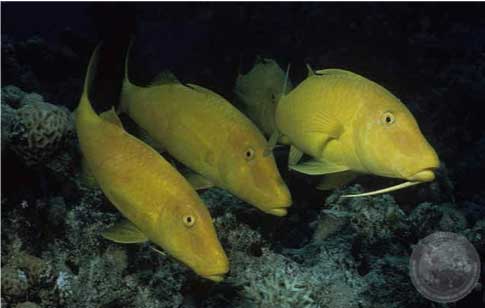Goatfish Information
Goatfish belong to the family Mullidae of the order Perciformes. Sometimes referred to as surmullets, there are at least 6 genera and 60 species of goatfish. They are primarily marine fish, but can sometimes be found in brackish water. They have a wide distribution in warm and tropical regions of the Atlantic, Indian and Pacific Oceans. A few places to name include the United States, Belize, Egypt, Philippines and Papua New Guinea. They tend to inhabit shallow water among reefs or over mud or sand. They are brightly colored with shades of red or yellow. They also have the ability to change their coloration depending on their activity though. Resting and feeding are two different activities where this would occur. For example, the diurnal goldsaddle goatfish, while feeding, will change from a lemon-yellow to a pale cream color.

These elongated fish can grow as large as 2 ft long, but most species of adult goatfish are smaller than this. They have two separated dorsal fins on their back and a soft, forked tail. One of the most distinct features of the goatfish is a pair of long, sensory chin barbels. These barbels are used for feeling around for prey on the floor. When they’ve located food, goatfish will plunge their snout through the sediment and inhale their prey along with the sand. The sand gets expelled via the gill cover afterward. When not in use, the barbels are held in a groove on the throat. During courtship, males will wriggle their barbels as well.
Their diet consists of mostly bottom-dwelling invertebrates such as worms, crustaceans, small molluscs, brittle stars and heart urchins, but they will sometimes eat smaller fish. It differs by species whether a goatfish hunts during the day or at night. Some diurnal species tend to be solitary but will school as juveniles. Goatfish are pelagic spawns who release their eggs into the water column where the offspring proceed to float freely with the currents until they hatch. Goatfish are edible and valued as food in some areas. There does not appear to be a huge urgency for conservation measures regarding goatfish at this time. Some areas do take precautions though to avoid overharvesting, such as a number cap included when fishing for goatfish in Maui.
